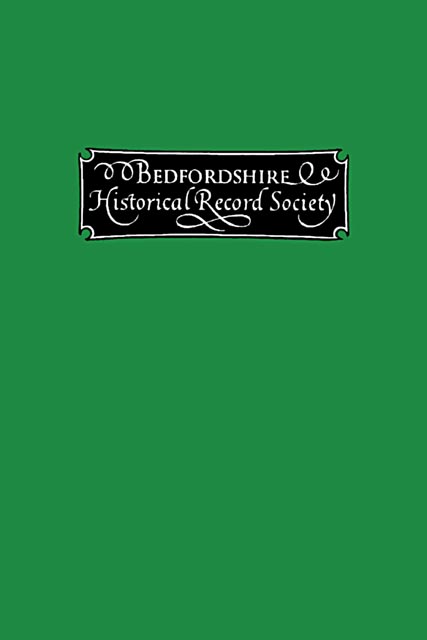Book contents
- Frontmatter
- Contents
- Abbreviations and Symbols
- The Shefford Beaker: circa 1800 B.C.
- The Morteyn Family in Bedfordshire
- The Shire of Bedford and The Earldom of Huntingdon
- The Later Descent of Wingate of Harlington
- The Disseisins by Falk de Breauté at Luton
- An Elizabethan Inquisition Concerning Bondmen
- Roll of The Justices in Eyre, 1240
- A List of Bedfordshire Apprentices: 1711 - 1720
- The Commune of Bedford
- Addendum I. “The Shire of Bedford and The Earldom of Huntingdon.”
- Addendum II. “The Disseisins of Falk de Breauté.”
- A Hand List of The Bedfordshire County Muniments : Prepared by The County Records Committee
- Index
The Shefford Beaker: circa 1800 B.C.
Published online by Cambridge University Press: 14 July 2023
- Frontmatter
- Contents
- Abbreviations and Symbols
- The Shefford Beaker: circa 1800 B.C.
- The Morteyn Family in Bedfordshire
- The Shire of Bedford and The Earldom of Huntingdon
- The Later Descent of Wingate of Harlington
- The Disseisins by Falk de Breauté at Luton
- An Elizabethan Inquisition Concerning Bondmen
- Roll of The Justices in Eyre, 1240
- A List of Bedfordshire Apprentices: 1711 - 1720
- The Commune of Bedford
- Addendum I. “The Shire of Bedford and The Earldom of Huntingdon.”
- Addendum II. “The Disseisins of Falk de Breauté.”
- A Hand List of The Bedfordshire County Muniments : Prepared by The County Records Committee
- Index
Summary
At the very beginning of the second millennium B.C. there appears in Britain a novel culture and a race of men not hitherto represented in this country. This new race was round-headed (brachy-cephalic); their dead were buried in a contracted position, sometimes in “flat” graves, but usually under a round, bowl-shaped barrow or cairn of stones. Associated with these “roundheads” in the round barrows we find well-made and elaborately decorated pottery vessels known as “beakers,” together with jet buttons, holed axes of stone, and daggers of copper, flint, or poor bronze. All these objects are characteristic of the period when the knowledge of metal was beginning to penetrate these islands, and when small tools of the precious and novel material were coming into the possession of chiefs and well-to-do tribesmen. This period may be dated between 2000 and 1700 B.C. The typical beaker is a tall pottery cup or mug, usually waisted, and sometimes handled. Its ornament consists of triangles, zig-zags or straight lines, impressed with a notched wheel or quadrant, built up into a variety of patterns in horizontal bands. The notched technique is varied by the use of a pointed stick or the finger nail; sometimes circles occur; these were impressed doubtless with a hollow reed or with a shoot of elder from which the pith had been removed.
The Beaker-pottery occurs all over Britain, but is most frequently met with on the East Coast from Kent to Caithness, in Derbyshire and in Wiltshire; a distribution which, when studied on the map, strongly points to overseas invasion and to landings at a variety of points on the East and possibly the South Coasts. On this hypothesis we suppose the Peak district to have been occupied by invaders pushing up the Trent valley; while the neolithic inhabitants of Salisbury Plain may have been ousted by men who, pressing along the chalk escarpment south-westward from the Fenlands, followed the route known to later peoples as the Icknield Way. The Beaker-folk must have been comparatively few in number, men who imposed themselves on the aboriginal population by physical and mental superiority; the purity of the race seems to have been lost by intermarriage, for in no long space of time their distinctive pottery disappears, and folk showing a variety of skull-form [long-headed (aboriginal), intermediate, and broadheaded] appear in the barrows.
- Type
- Chapter
- Information
- Publisher: Boydell & BrewerFirst published in: 2023



